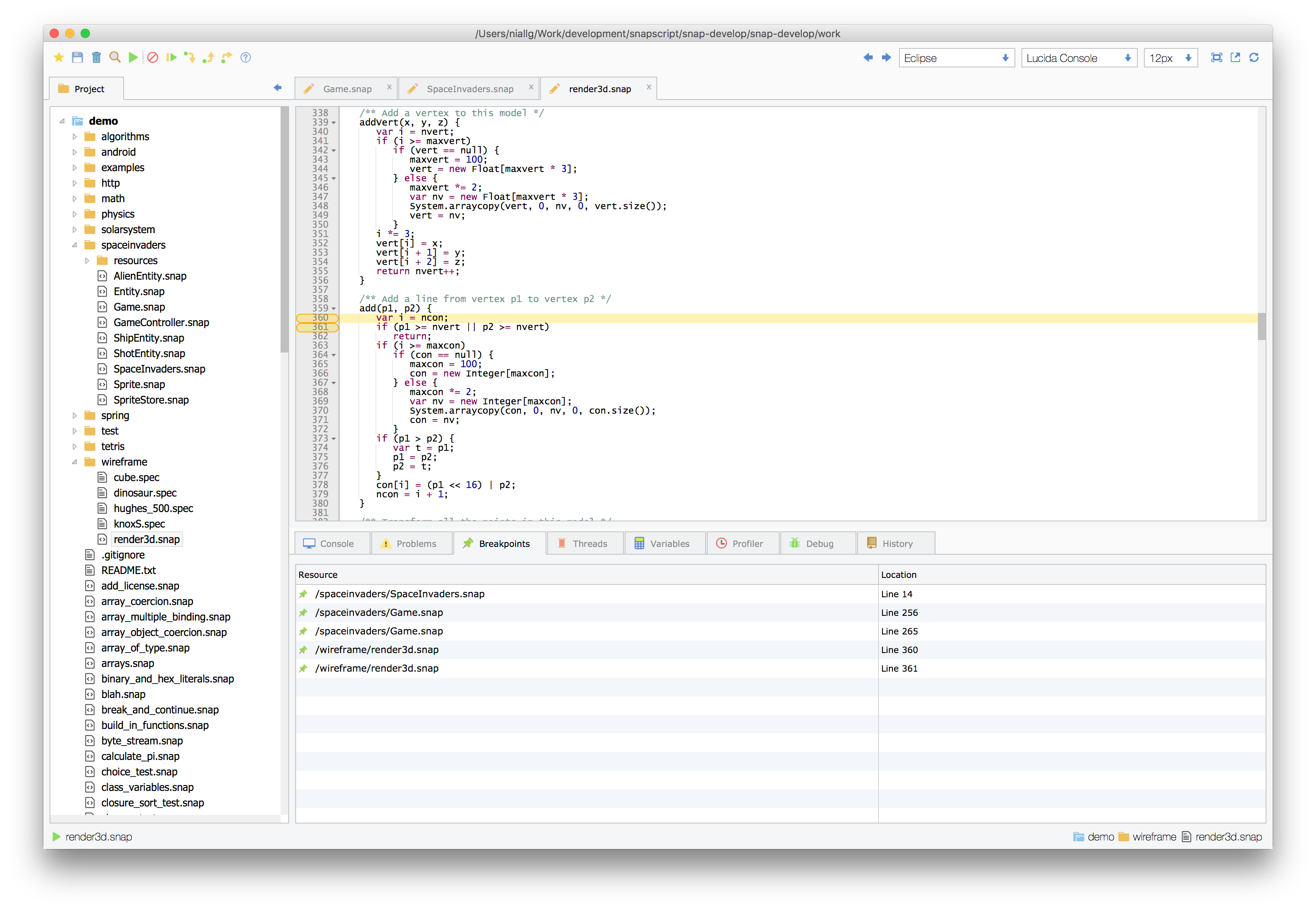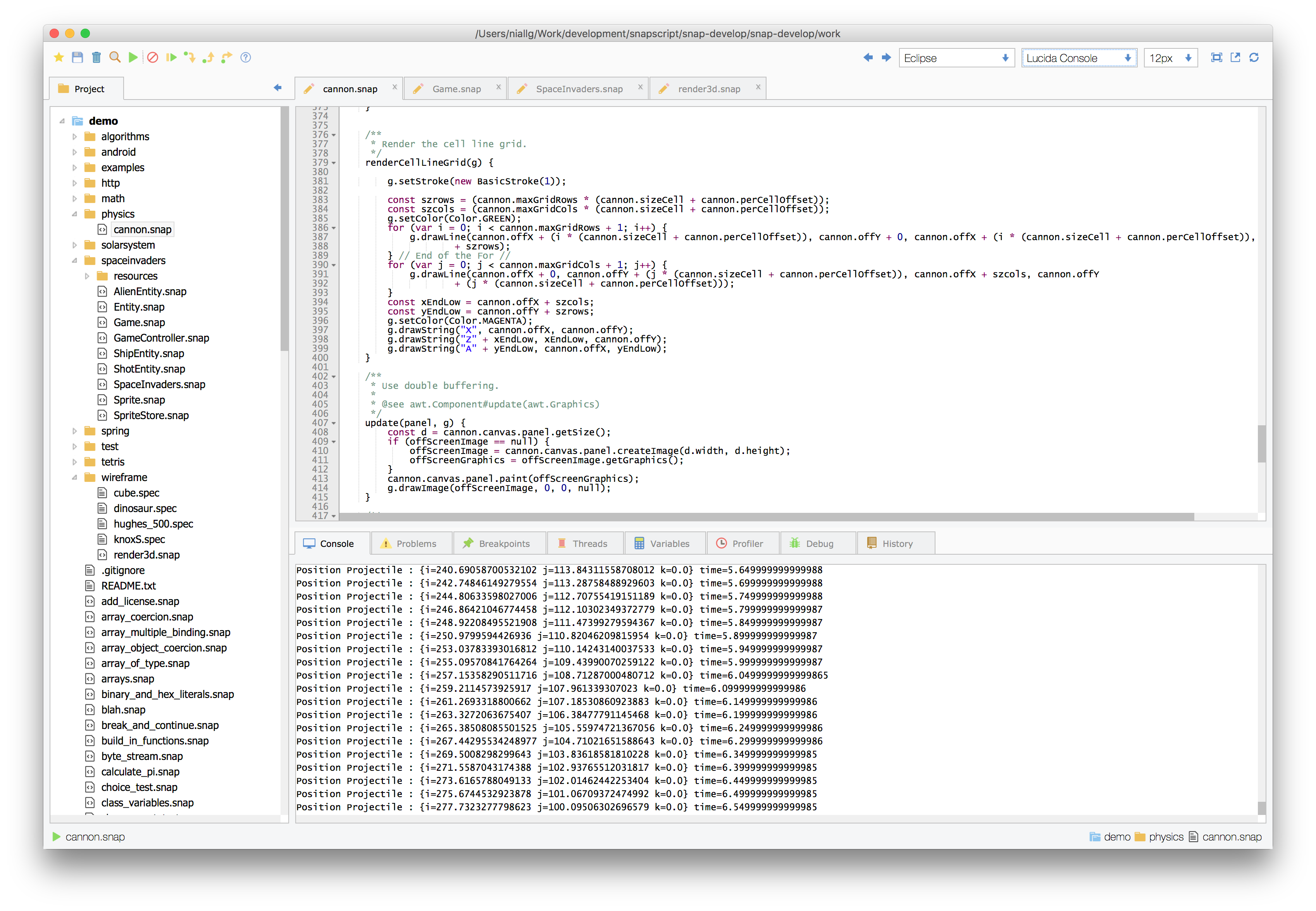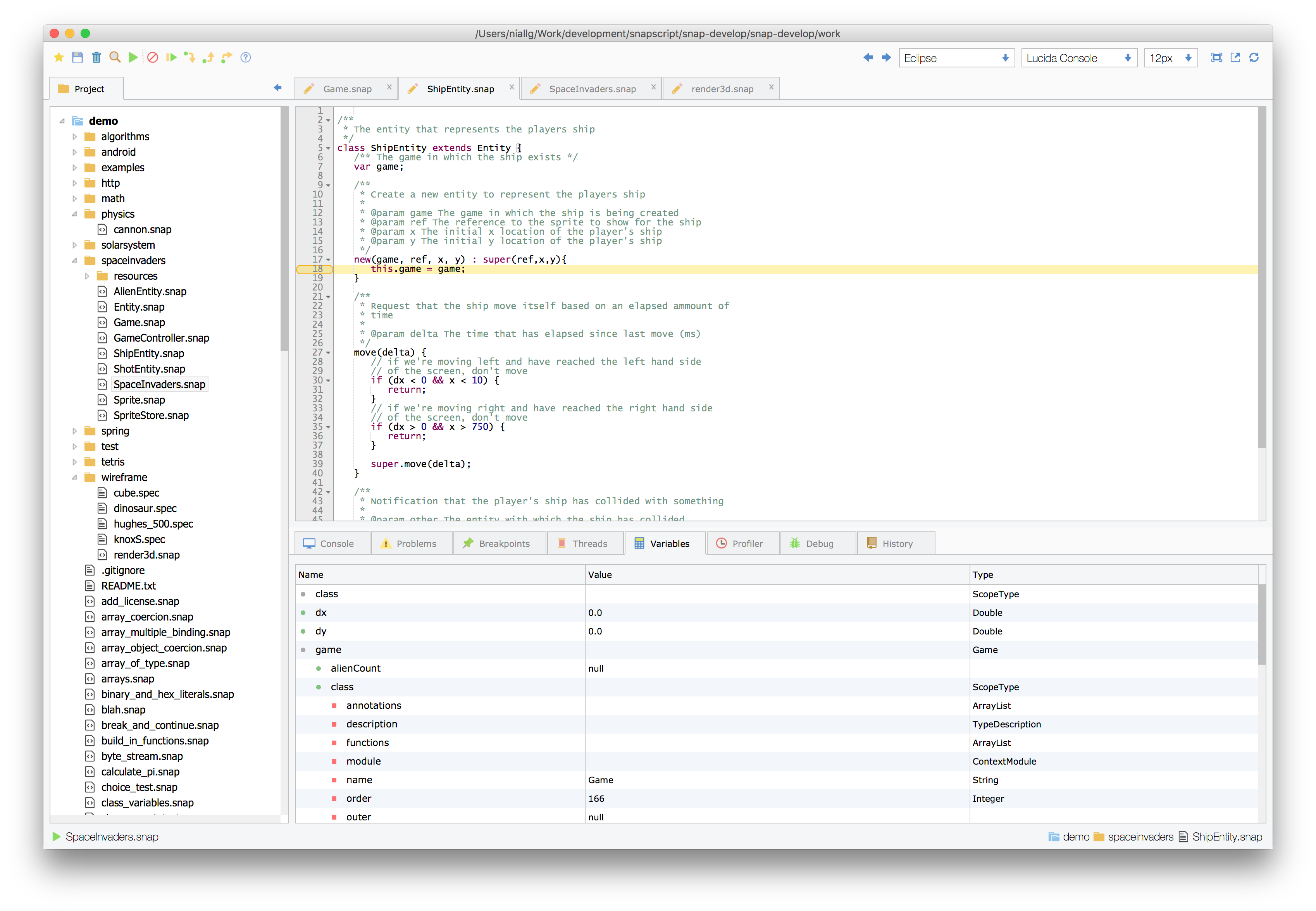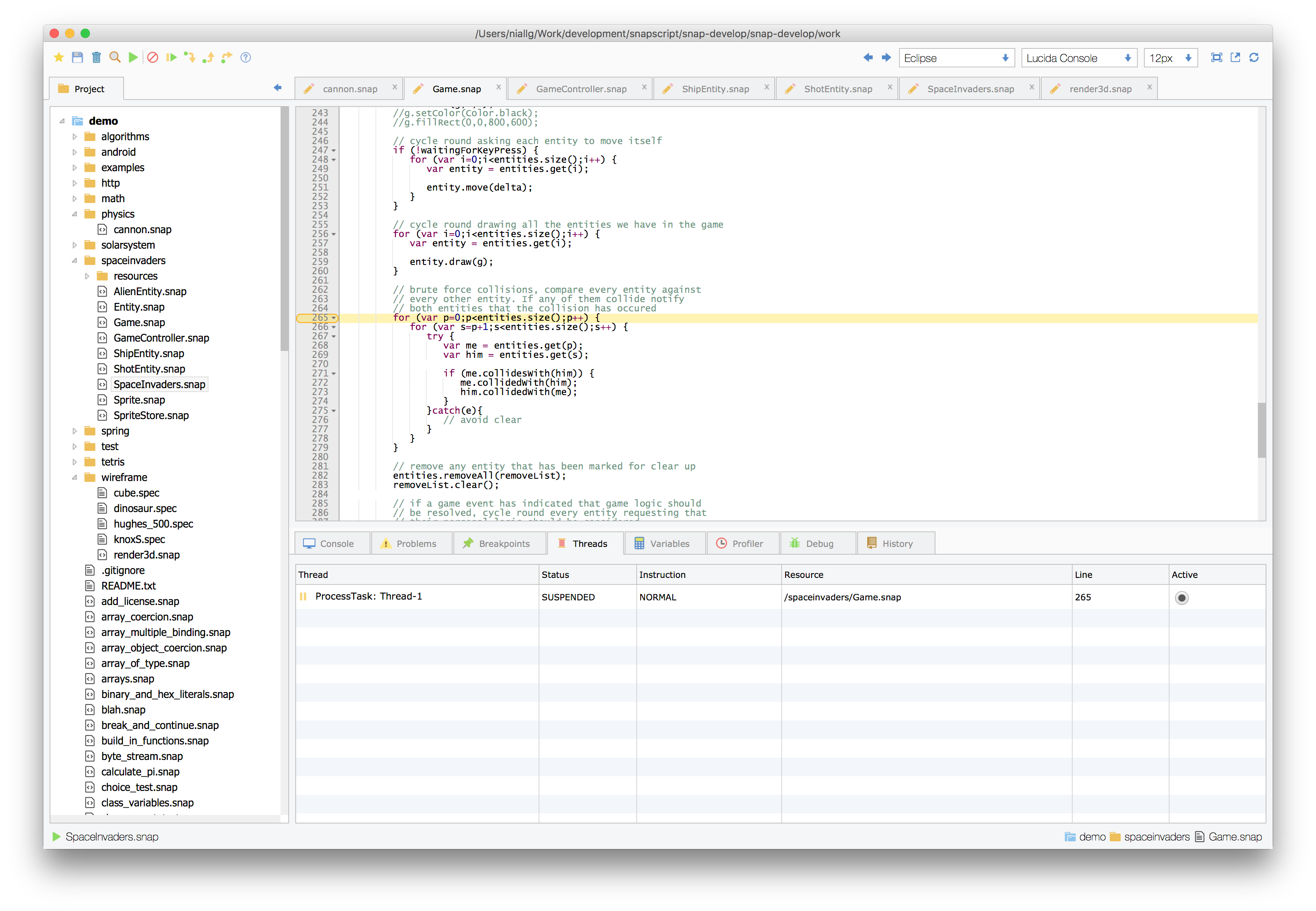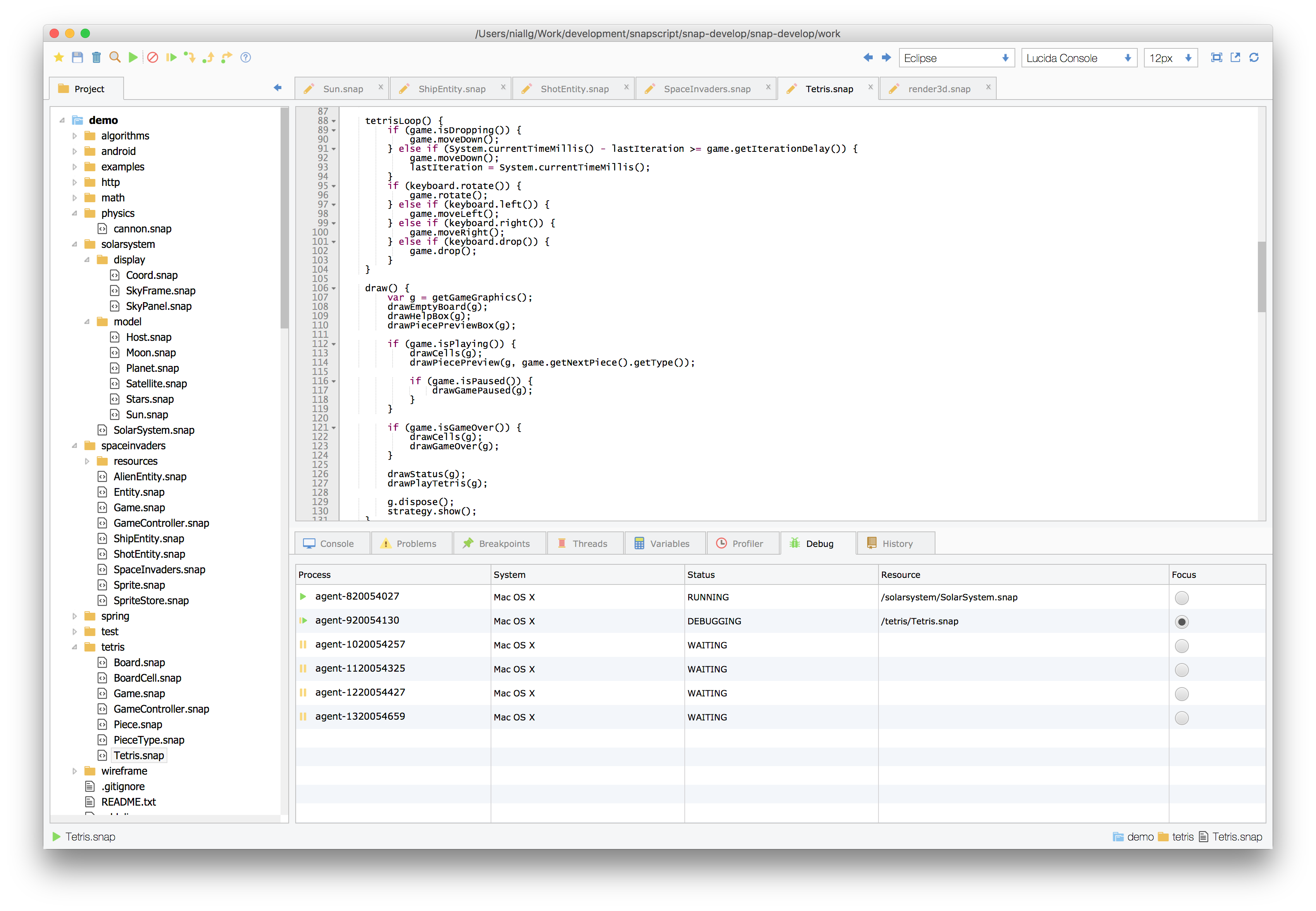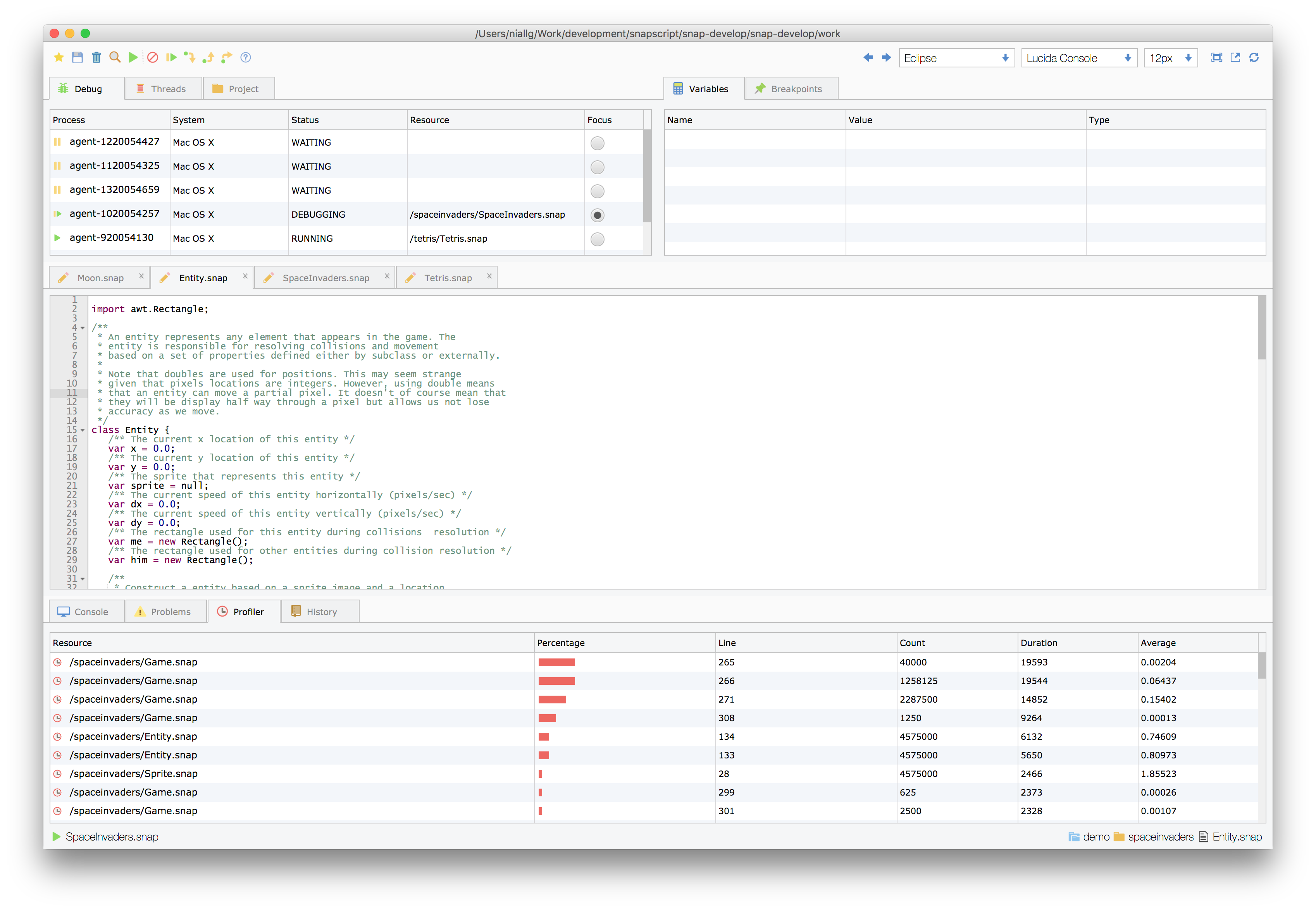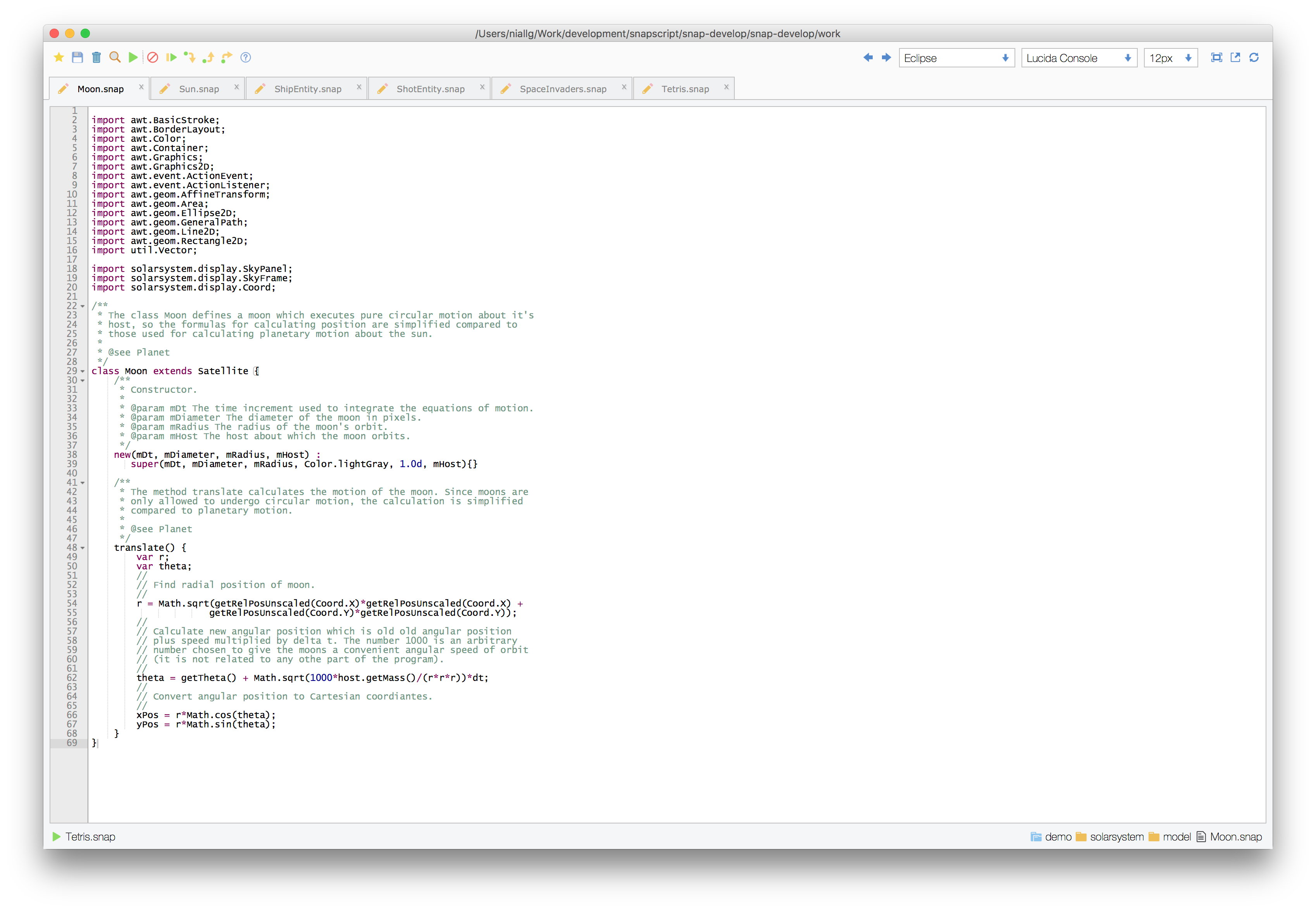Snap is an open source, optionally typed, object oriented scripting language for the Java platform. The learning curve is small for anyone with experience of Java, JavaScript, TypeScript, or Scala, amongst others. It has excellent integration with the host platform, and can do whatever can be done with Java and much more.
Snap is an open source, optionally typed, object oriented scripting language for the Java platform. The learning curve is small for anyone with experience of Java, JavaScript, TypeScript, or Scala, amongst others. It has excellent integration with the host platform, and can do whatever can be done with Java and much more.
The language is ideal for embedding in to an existing application, and is a fraction of the size of similar languages for the Java platform. In addition to embedding it can be run as a standalone interpreter and has an development environment which allows scripts to be debugged and profiled.
Snap programs can be separated in to multiple source files that define the types and functions that represent the execution flow. To minimise start time the parsing and assembly of the source is performed in parallel. Once defined the execution graph is joined in to a single executable and static analysis is performed.
The command directive is used to tell command interpreters where the interpreter for the source is located. This is is often called the 'shebang' directive and is interpreted by common shells like bash. The first line of any Snap source file can contain this command directive.
#!/usr/bin/env snap
Source Code - Statically Typed
Source Code - Dynamically Typed
For programs to be useful, we need to be able to work with some of the simplest units of data such as numbers, strings, structures, boolean values, and the like. Support for these basic types is much the same as you would expected for Java, with some additional features such as string templates, map, set, and list literals.
In order to reference values they must be associated with a variable. Variables are declared with the keyword var or const. A variable can have an optional constraint by declaring a type. If constrained a variable can only reference values of the declared type.
let v = 22; // v can reference any type
let i: Integer = 22; // i can only reference integers
let d: Double = 22.0; // d can only reference doubles
const c = 1.23; // c is constant, it cannot changeThe most basic type is the simple true or false value, which is called a boolean value.
let a = true; // value a is true
let b = false; // false
let c = Boolean.FALSE; // type constraint of Boolean
let d: Boolean = Boolean.TRUE; // like Boolean d = Boolean.TRUE
let e = Boolean.FALSE; // like Object e = Boolean.FALSEThe most basic type is the simple true or false value, which is called a 'boolean' value.
let binary = 0b0111011; // binary literal
let hex = 0xffe16; // hexidecimal literal
let int = 11;
let long = 11L;
let double = 0.5d;
let float = 12.9f;
let typed: Integer = 22; // integer value 22
let coercion: Double = "1.234e2"; // coercion of string to doubleA fundamental part of creating programs is working with textual data. As in other languages, we use the type string to refer to these textual types. Strings are represented by characters between either a single quote or a double quote. When characters are between double quotes they are interpolated, meaning they have expressions evaluated within them. These expressions start with the dollar character. All strings can span multiple lines.
let string = 'Hello World!'; // literal string
let template = "The sum of 1 and 2 is ${1 + 2}"; // interpolated string
let concat = "The sum of 1 and 2 is " + (1 + 2); // concatenationThe most basic type is the simple true or false value, which is called a 'boolean' value.
let array = new String[10]; // array of strings
let bytes = new Byte[11]; // primitive byte[11]
let byte = array[1]; // reference element in array
let matrix = new Long[10][22]; // multidimensional long[10][22];
let long = matrix[2][3]; // reference multidimensionalComplex data structures can be represented with a simple and straight forward syntax. Collection types found in Java such as maps, sets, and lists can be represented as follows.
let set = {1, 2, "x", "y"}; // creates a LinkedHashSet
let list = [1, 2, 3]; // creates an ArrayList
let map = {"a": 1, "b": 2}; // creates a LinkedHashSet
let empty = {:}; // creates an empty map
let mix = [1, 2, {"a": {"a", "b", [55, 66]}}]; // mix collection typesOperators are special symbols that perform specific operations on one, two, or three operands, and then return a result. They are typically used to manipulate or compare values.
Arithmetic operators are used in mathematical expressions in the same way that they are used in algebra.
let a = 10;
let b = 20;
let c = a + b; // add is 30
let d = b - a; // subtract is 10
let e = b / a; // divide is 2
let f = a * b; // multiply is 200
let g = b % a; // modulus is 0
let h = a++; // a is 11 and h is 10
let i = b--// b is 19 and i is 20
let j = --a; // a is 10 and j is 10
let k = ++b; // b is 20 as is kRelational operators are used to make comparisons, such as equal to, not equal to, greater than, less than.
let a = 10;
let b = 20;
let c = a == b // equal operator, c is false
let d = a != b; // not equal operator, d is true
let e = a > b; // greater than operator, e is false
let f = a < b; // less than operator, f is true
let g = a <= b; // g is false
let h = a >= b; // h is trueBitwise operators are used to manipulate numbers, typically integers, at the byte level. They do so by change the binary representation of the value.
let a = 0b00111100;
let b = 0b00001101;
let c = a & b; // bitwise and, c is 00001100
let d = a | b; // bitwise or, d is 00111101
let e = a & b; // bitwise xor, e is 00110001
let f = ~a; // f is 11000011
let g = f >> 2; // f is 00110000
let h = f << 2; // h is 11000000
let i = f >>> 2; // unsigned shift, i is 00110000Logical operators are typically used to combine multiple relational operations in to a single boolean result.
let a = 1;
let b = 3;
let c = true;
let d = false;
let e = a && b; // e is false
let f = a || b; // f is true
let g = !d; // not operator, g is true
let h = b > a && a == 1; // logical and of, h is true
let i = b > a && a != 1; // i is falseConditional statements are used to perform different actions based on different conditions.
The if statement is used to specify a group of statements to execute if a statement is true.
const a = 2;
const b = 3;
if(a < b) { // true
println("a > b"); // prints as a < b
}The else statement is used to specify a group of statements to execute if a statement is false.
const a = 2;
const b = 3;
if(a >= b) { // false
println("a >= b");
} else {
println("a < b"); // prints as a < b
}The unless statement is used to specify a group of statements to execute if a statement is false.
const a = 2;
const b = 3;
unless(a > b) { // false
println("a > b"); // prints as a < b
}The assert statement is used to determine if an expression evaluates to true or false. If the expression evaluates to true the operation has no effect, otherwise an assertion exception is thrown.
const a = 2;
const b = 3;
assert a < b;
assert a > b; // assert exceptionThe debug statement is used to suspend any attached debugger if and expression evaluates to true. This can be useful if there is a specific part of the program that you want to evaluate given a known state of execution. It is similar to the debugger statement for JavaScript with the addition of logic predicate the suspension.
debug a * b > 4; // suspend the debugger if trueTo make statements more concise there is a ternary operator.
let a = 2;
let b = 3;
println(a >= b ? "a >= b" : "a < b"); // prints a < bThe null coalesce operator is similar to the ternary operator with one exception, the evaluation is whether a value is null.
let a = null;
let b = 3;
println(a ?? b); // prints bLoops are used to perform a group of statements a number of times until a condition has been satisfied.
The while statement is the simplest conditional statement. It repeats a group of statements while the condition it evaluates is false.
let n = 0;
while(n < 10) { // conditional loop
n++;
}The for statement is typically used to count over a range of numeric values. It contains three parts, a declaration, a condition, and an optional statement which is evaluated at the end of the loop.
for(let i = 0; i < 10; i++){ // loops from 1 to 10
if(i % 2 == 0) {
continue; // continue loop
}
println(i); // prints only odd numbers
}The for in statement offers a simpler way to iterate over a range of values, a collection, or an array.
let list = [35, 22, 13, 64, 53];
for(e in list){ // iterates over the list
println(e);
}
for(e in 0..9) { // iterates from 0 to 9
if(e == 7) {
break; // exit loop when e is 7
}
println(e); // prints from 0 to 6
}The loop statement offers a way to specify an infinite loop, it does not evaluate any condition.
let n = 0;
loop { // infinite loop
if(n++ > 100) {
break;
}
}Exceptions are used to indicate an error has occurred. It offers a simple means to return control to a calling function, which can then handle the error. Typically an exception object is thrown, however it is possible to throw any type.
In order to catch an exception the throwing statement needs to be wrapped in a try catch statement. This statement basically allows the program to try to execute a statement or group of statements, if during execution an exception is thrown then an error handling block is executed.
try {
throw new IllegalStateException("some error");
} catch(e: IllegalStateException) {
e.printStackTrace();
}The finally statement is a group of statements that are always executed regardless of whether an exception is thrown..
try {
throw "throw a string value";
} catch(e) {
println(e);
} finally {
println("finally always runs");
}Functions group together control structures, operations, and method calls. These functions can then be called when needed, and the code contained within them will be run. This makes it very easy to reuse code without having to repeat it within your script.
The most basic type of function is declared with a name and a specific number of parameters. Such a method can then be called using the declared name by passing in a right number of arguments.
let r = max(11, 3, 67); // r is 67
func max(a, b) {
return a > b ? a : b;
}
func max(a, b, c) { // function overloading
return a < b ? max(a, c) : max(b, c);
}In order to bind invocations to the correct function implementation it can be declared with optional type constraints. These type constraints will ensure that variables of a specific type will be bound to the correct implementation.
let x: Double = 11.2;
let y: Integer = 11;
let z: String = "11";
f(x); // prints double 11.2
f(y); // prints integer 11
f(z); // prints string 11
f(true); // type coercion to string, prints string true
func f(x: Integer) {
println("integer ${x}");
}
func f(x: Double) {
println("double ${x}");
}
func f(x: String) {
println("string ${x}");
}At times it can be useful to provide a large number of arguments to a function. To achieve this the last parameter can be declared with a variable argument modifier.
let result = sum(0, 13, 44, 234, 1, 3);
func sum(offset, numbers...){ // variable arguments
let size = numbers.size();
let sum = 0;
for(let i = offset; i < size; i++){
sum += number;
}
return sum;
}A closure is an anonymous function that captures the current scope and can be assigned to a variable. This variable can then act as a function and can be called in the same manner.
const square = (x) -> x * x;
const cube = (x) -> square(x) * x;
cube(2); // result is 8
const printAll = (values...) -> {
for(var e in values) {
println(e);
}
}
printAll(1, 2, 3, 4); // print all valuesA function handle is simply a way to reference an existing function as a closure. Function handles can represent constructors or functions that are in scope. For example take the constructor for a string, it is quite possible to execute the following.
['a', 'b', 'c'].iterator.forEachRemaining(this::println)Here we are calling the println function with the item passed to the function. This function is represented as a function handle that takes a string. A function handle can represent a static or an instance function. For example:
class Formatter {
public static upper(s: String) {
return s.toUpperCase();
}
}
['a', 'b', 'c'].stream().map(Formatter::upper).forEach(this::println);Generics can be used to qualify the arguments that can be passed to a function. They are useful when the static analyser verifies the program as it ensures arguments and return types match the declared qualifiers.
func abs<T: Number>(nums: T): List<T> {
let result: List<T> = [];
for(num in nums) {
let abs = num.abs();
result.add(abs);
}
return result;
}
let list: List<Double> = abs<Double>(-1.0, 2.0, -3.0);
assert list[0] == 1;
assert list[2] == 2;It is often useful to suspend execution of a function in order to return a result. Typically this requires a great deal of effort from the developer. Coroutines allow an idomatic means of suspending the execution of a function which can be resumed at the point of suspension. This allows for complex reactive iteration to be performed with minimal effort. For example take a Fibonnaci sequence.
func fib(n){
let a = 1;
let b = 2;
until(n-- <= 0) {
yield a;
(a, b) = (b, a + b);
}
}Asynchronous functions can be implemented with the async and await modifiers. This is similar to a standard Coroutine however this paradigm will allow the execution of the program to fork in two different threads of execution.
async loadImage(n: String): Promise<?> {
return await ImageIO.read(n);
}Blank parameters allow you to specify an argument that is not needed or can be ignored.
func create<T>(type: T): T {
return cache.computeIfAbsent(type.name, (_) -> new T());
}In any substantial application types are required. A type is basically a way to define an encapsulate variables and functions within a named scope.
A class is the most basic type. It contains variables and functions that can operate on those variables. Once declared a type can be instantiated by calling a special function called a constructor.
class Circle {
private static const PI = 3.14; // enclosed variables
private let radius;
new(radius) { // constructor
this.radius = radius;
}
area() {
return PI * r * r;
}
diameter() {
return 2 * r;
}
}
let circle = new Circle(10);
circle.area(); // calculate areaAn enumeration is a type that specifies a list of constant values. This values are constant and are instances of the enum they are declared in.
enum Color {
RED("#ff0000"),
BLUE("#0000ff"),
GREEN("#00ff00");
let rgb;
new(rgb) {
this.rgb = rgb;
}
}
let red = Color.RED;
let blue = Color.BLUE;A trait is similar to a class in that is specifies a list of functions. However, unlike a class a trait does not declare any variables and does not have a constructor. It can be used to add functions to a class.
trait Format
format(a);
}
class BoldFormat with Format{
override format(a) {
return "<b>${a}</b>";
}
}
class ItalicFormat with Format {
override format(a) {
return "<i>${a}</i>";
}
}A module is collection of types, functions, and variables. It is similar to enclosing a script within a named type. Modules are useful in providing constructs such as singletons.
module ImageStore {
private const cache = {:};
public find(name) {
return cache.get(name);
}
private cache(name, image) {
cache.put(name, image);
}
} In order to access the Java types available they can be imported by name. Once imported the type can be instantiated and used as if it was a script object. In addition to importing types, functions can also be imported by using a static import.
import static lang.Math.*; // import static functions
import security.SecureRandom;
const random = new SecureRandom(); // create a java type
const a = random.nextInt(40);
const b = random.nextInt(40);
const c = max(a, b); // Math.max(a, b)
println(c); // prints the maximum randomFor interfaces that have only a single method a closure can be coerced to that interface type. This makes for a much simpler and concise syntax similar to that offered by Java closures.
const set = new TreeSet((a,b)->Double.compare(a,b));
set.add(1.2);
set.add(2.3);
set.add(33.4);
set.add(4.55);
set.add(2);
for(entry in set){
println(entry);
}To leverage the large array of frameworks and services available on the Java platform any Java type can be instantiated, and any Java interface can be implemented.
class DoubleComparator with Comparator{
override compare(a,b){
return Double.compare(a,b);
}
}
let comparator = new DoubleComparator();
let set = new TreeSet(comparator);
set.add(1.2);
set.add(2.3);
set.add(33.4);
set.add(4.55);
set.add(2);
for(let entry in set){
println(entry);
}


